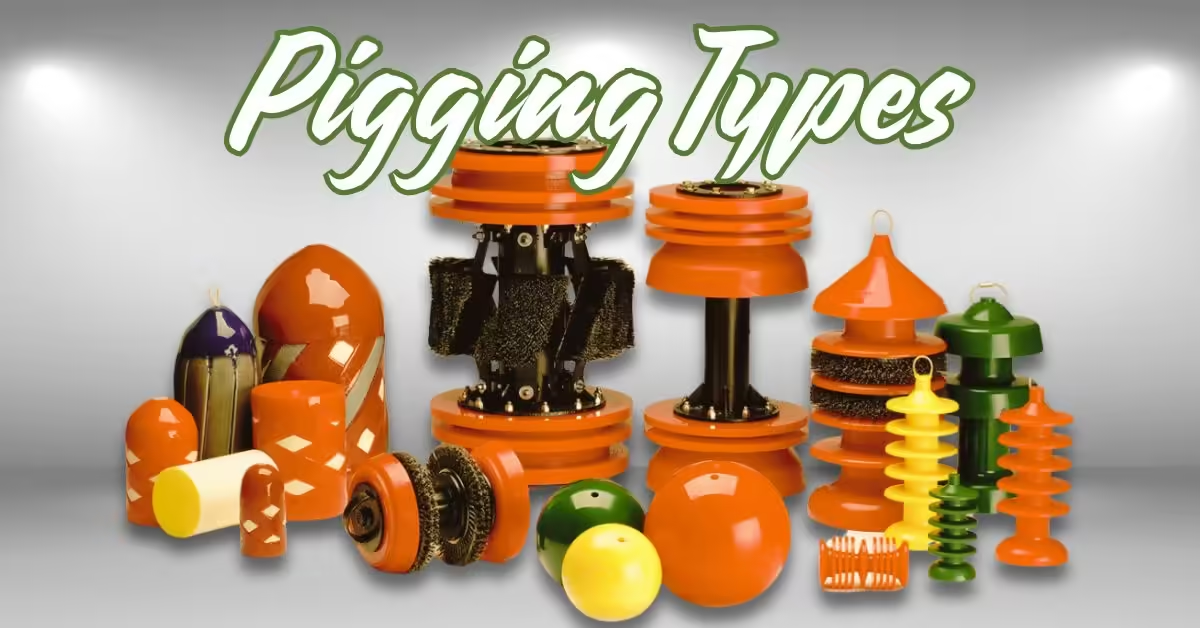The pigging process plays an essential role in industries such as oil and gas, chemicals, and food production. It involves using a device, commonly known as a “pig,” to clean and maintain pipelines or recover products. With various pigging types available, choosing the right one for your needs can optimize operations and improve efficiency. In this article, we’ll explore 5 common pigging types, their applications, and how they contribute to effective pipeline management.
1. What is Pigging? An Overview of the Industrial Pigging Process
Before diving into the types of pigging systems, it’s important to understand what pigging is and why it’s vital in industries. Pigging is a technique used to maintain and clean pipelines by sending a “pig” (a device designed for this purpose) through the pipeline. The industrial pigging process removes debris, clears blockages, and ensures smooth product flow.
Benefits of the Pigging Process:
- Improves pipeline efficiency: Regular pigging reduces the buildup of debris and blockages.
- Increases product recovery: Especially in industries like food and chemicals, pigging ensures the recovery of valuable products left in pipelines.
- Pipeline inspection: Advanced intelligent pigging types can inspect the internal condition of pipelines and detect issues before they become serious.
Understanding pigging is crucial for businesses relying on long pipelines for product transport or processing, and it forms the foundation for the different types of pigs used.
2. Pipeline Pigging Types: How They Work and Their Applications
There are several types of pipeline pigging methods used in various industries, each designed for specific tasks such as cleaning, inspection, and product recovery. Let’s look at the most common pipeline pigging types and their applications:
1. Cleaning Pigs:
- Purpose: Cleaning pigs are used to remove debris, scale, and product buildup from the pipeline walls.
- Application: Industries like oil and gas often use cleaning pigs to keep pipelines clear of obstructions, ensuring smooth flow and avoiding costly repairs.
- Types of cleaning pigs: Foam pigs, brush pigs, and scraper pigs are commonly used for pipeline cleaning.
2. Sealing Pigs:
- Purpose: These pigs help to form a tight seal between the pig and the pipeline, pushing out any residual liquids or gases.
- Application: Sealing pigs are critical in pipeline commissioning, testing, and decommissioning phases.
3. Inspection Pigs (Intelligent Pigs):
- Purpose: Also known as “smart pigs,” inspection pigs gather data on the pipeline’s condition, detecting corrosion, cracks, or leaks.
- Application: Commonly used in oil and gas pipelines to monitor pipeline integrity.
4. Batching Pigs:
- Purpose: Used to separate different products flowing through the same pipeline.
- Application: Particularly useful in chemical and petroleum industries to prevent product mixing.
5. Specialty Pigs:
- Purpose: These pigs are designed for unique applications, such as wax removal or extremely high-pressure pipelines.
- Application: Specialty pigs are customized for challenging pipeline conditions.
3. Intelligent Pigging Types: Advanced Solutions for Pipeline Inspection
Intelligent pigging types represent the most advanced methods for pipeline inspection. These pigs are equipped with sensors, cameras, and other technologies to perform detailed inspections while traveling through pipelines.
How Intelligent Pigging Works:
- Data collection: Intelligent pigs collect real-time data on pipeline conditions, including metal loss, corrosion, and even physical deformation.
- Non-destructive testing: The process doesn’t damage the pipeline, allowing for inspection while the pipeline remains operational.
- Detailed reporting: After the pigging run, data is analyzed to provide detailed reports on the pipeline’s structural health.
Types of Intelligent Pigs:
- Magnetic Flux Leakage (MFL) Pigs: Detects corrosion and metal loss.
- Ultrasonic Pigs: Measures the thickness of pipeline walls and detects cracks.
- Caliper Pigs: Identifies deformations or dents in the pipeline.
Intelligent pigging types are essential for ensuring pipeline safety, especially in high-stakes industries like oil and gas, where early detection of damage can prevent costly disasters.
4. The Benefits of Pigging for Product Recovery in Industries
One of the key advantages of using pigging is its ability to recover residual products left in pipelines. This is especially important in industries like food processing, pharmaceuticals, and chemicals, where leftover products can lead to waste and reduced profits.
How Pigging Improves Product Recovery:
- Minimizes waste: Pigging systems remove the remaining product from pipelines, ensuring maximum recovery.
- Saves costs: By recovering more product, businesses can reduce the amount of waste and increase profitability.
- Cleaner pipelines: A clean pipeline means less product contamination and easier switching between products.
For industries where product recovery is essential, the right pigging types can lead to significant financial and environmental benefits.
5. Types of Cleaning Pigs Used in Pipeline Maintenance
Cleaning pigs are among the most commonly used pipeline pigs. Their primary function is to remove debris, scale, and deposits that accumulate inside pipelines, keeping them clean and functional. Different types of cleaning pigs are used based on the pipeline material, size, and the nature of the debris.
Types of Cleaning Pigs:
- Foam Pigs: Lightweight and flexible, foam pigs are ideal for soft cleaning tasks where heavy-duty scraping isn’t necessary.
- Brush Pigs: Equipped with wire brushes, these pigs are perfect for removing harder deposits and built-up material from pipeline walls.
- Scraper Pigs: Designed to scrape off tough deposits like rust or scale, scraper pigs provide a more intense cleaning action.
Regular use of cleaning pigs prevents blockages, enhances pipeline efficiency, and reduces the risk of corrosion or damage.
6. How to Choose the Right Pigging System for Your Industry
Choosing the right pigging system depends on several factors, including the type of pipeline, the industry, and the specific tasks that need to be performed. Here are some considerations to help you select the right pigging types for your operations.
Key Considerations:
- Pipeline Material: Different pigs work best with different pipeline materials. For instance, foam pigs are better for plastic pipelines, while scraper pigs are ideal for metal pipes.
- Purpose of Pigging: Whether you need the system for cleaning, product recovery, or inspection, the type of pigging system you choose will depend on your primary goal.
- Pipeline Length and Diameter: The size of your pipeline will determine the type of pig you need. Larger pipelines require more robust pigs, while smaller ones can use lightweight options like foam pigs.
- Operating Environment: Consider the operating conditions of your pipeline, such as temperature, pressure, and the types of fluids being transported.
By taking these factors into account, you can choose the best pigging types for your industry, ensuring efficient operation and maximum product recovery.
Types of Pigs Used in Oil and Gas Pipelines: Ensuring Safety and Efficiency
Pigging plays a crucial role in maintaining the integrity of oil and gas pipelines. In this sector, where long pipelines transport hazardous materials, it’s essential to keep them clean, efficient, and well-monitored. Various types of pigs are used for different purposes in this industry, depending on the pipeline’s needs.
Common Pig Types in Oil and Gas:
- Cleaning Pigs: Remove wax, debris, and scale that naturally accumulate in oil pipelines. This ensures an uninterrupted flow of materials, which is critical to the efficiency of operations.
- Intelligent Pigs: These inspection pigs are often used in oil and gas pipelines to detect internal corrosion, cracks, or weld defects. Given the high stakes in this industry, frequent inspection helps prevent leaks and pipeline failures.
- De-watering Pigs: After hydrostatic testing, de-watering pigs remove any leftover water, preventing corrosion and ensuring the pipeline is dry before use.
By using these pipeline pigging types, the oil and gas industry can maintain higher operational safety, prevent costly pipeline damage, and minimize environmental risks.
How Pigging Systems Improve Pipeline Lifespan
One of the primary benefits of pigging systems is their ability to extend the lifespan of a pipeline. By regularly using different pigging tools, industries can reduce corrosion, prevent buildup, and identify potential problems early.
Key Ways Pigging Extends Pipeline Lifespan:
- Prevents blockages: Regular cleaning ensures the pipeline remains clear of obstructions that could lead to pressure build-up.
- Reduces wear and tear: By identifying and addressing issues like corrosion early on, intelligent pigging types help minimize long-term damage.
- Increases operational efficiency: Cleaner pipelines operate more smoothly, reducing the strain on the system.
With regular pigging, pipelines can run efficiently for longer, reducing maintenance costs and the need for frequent repairs.
For more tips and guides, visit our homepage at My Read Magazine and explore a world of helpful content!
Conclusion
In conclusion, pigging types play a critical role in maintaining the efficiency and safety of pipelines across various industries. From cleaning and product recovery to advanced inspection systems like intelligent pigging, the right pigging system can significantly improve pipeline performance and reduce costs.
Whether you’re involved in the oil and gas, chemical, or food industry, understanding the different pipeline pigging types and their applications will help you choose the right system for your needs. Regular use of the appropriate pigs ensures cleaner pipelines, better product recovery, and enhanced operational safety.
FAQs About Pigging Types
- What are the different types of pigs used in pipelines?
Common types include cleaning pigs, sealing pigs, inspection pigs, batching pigs, and specialty pigs. - What is intelligent pigging?
Intelligent pigging involves using advanced pigs equipped with sensors and cameras to inspect pipelines for damage. - What is the main purpose of pigging in pipelines?
Pigging is used for cleaning, inspecting, and recovering products from pipelines to maintain their efficiency and safety. - Can pigging be used in industries other than oil and gas?
Yes, pigging is widely used in industries like food, chemicals, and pharmaceuticals for product recovery and pipeline maintenance. - How does intelligent pigging work?
Intelligent pigs collect data on pipeline conditions using sensors and cameras, providing detailed information about corrosion, cracks, or deformations. - What are cleaning pigs used for?
Cleaning pigs remove debris, scale, and other deposits from the walls of pipelines, ensuring smooth flow and preventing blockages. - How often should pigging be done?
The frequency of pigging depends on the industry and the pipeline’s use, but regular pigging ensures better pipeline performance and longevity. - What are foam pigs?
Foam pigs are lightweight, flexible pigs used for soft cleaning tasks and removing light debris from pipelines. - Why is pigging important for product recovery?
Pigging helps recover the remaining product from pipelines, reducing waste and increasing profitability. - What industries benefit the most from pigging?
Industries like oil and gas, food processing, pharmaceuticals, and chemicals benefit the most from regular pigging for pipeline maintenance and product recovery.

Joseph Bush is a seasoned writer and researcher with over 7 years of experience covering a wide range of general topics, from lifestyle and technology to business and current events. He is dedicated to producing fact-checked, reader-friendly content that informs, engages, and empowers readers.
Throughout his career, Joseph has followed strict editorial guidelines, relied on reputable sources, and ensured every article meets the highest standards of accuracy and clarity. His expertise spans multiple fields, allowing him to explain complex topics in a way that’s easy to understand.
Passionate about continuous learning, Joseph stays updated on industry trends and best practices to deliver trustworthy, well-rounded insights. Readers can rely on his work for its credibility, depth, and real-world relevance.




